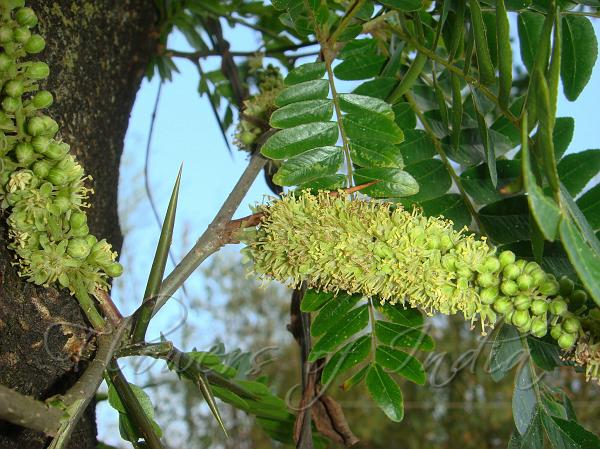|
| Honey Locust |
|

|

| File size | 1096993 |
| Original date | 4/17/08 3:58 PM |
| Resolution | 2048 x 1536 |
| Flash | Flash fired, return detected, red-eye reduction |
| Focal length | 6.33mm |
| Exposure time | 1/160s |
| Aperture | 3.5 |
| Focus Distance | |
| Metering Mode | Multi-segment |
| Camera make | SONY |
| Camera model | DSC-T20 |
| Sensor type |
|
|
|
|
Photo: |
Botanical name: Gleditsia triacanthos Family: Caesalpiniaceae (Gulmohar family)
Native to North America, Honey locust is a medium sized deciduous tree with
black bark, and branches growing zigzag. It can be seen planted in
Manipur. It is easily identified by its pinnate leaves and large thorns.
The trunk and larger branches are full of stout, rigid, branched thorns
7-20 in long. Honeylocust usually stands around 40-80 ft tall and has an
open plume-like crown of divided leaves that spreads 20-30 ft across. In
its native habitat, it can be 140 ft tall and have trunks 6 ft in diameter.
Honeylocust leaves are compound and sometimes double compound, 7-8 in long,
and divided into a hundred or more 1 in oval leaflets. The fragrant
greenish yellow flowers hang in small, inconspicuous clusters in early
summer. The seeds are borne in pods which are dark purplish brown, flat and
corkscrew twisted, 10-18 in long and about 1 in wide. The pods frequently
persist on the tree after leaf fall into early winter. The seeds resemble
oval bean seeds and are surrounded within the pods by a sweet and juicy
pulp. Despite its name, Honey locust is not a significant honey plant. The
name derives from the sweet taste of the legume pulp, which was used for
food by Native American people, and can also be fermented to make beer.
Flowering: April-June.
| Identification credit: Thingnam Sophia | Photographed in Imphal, Manipur. |
• Is this flower misidentified? If yes,